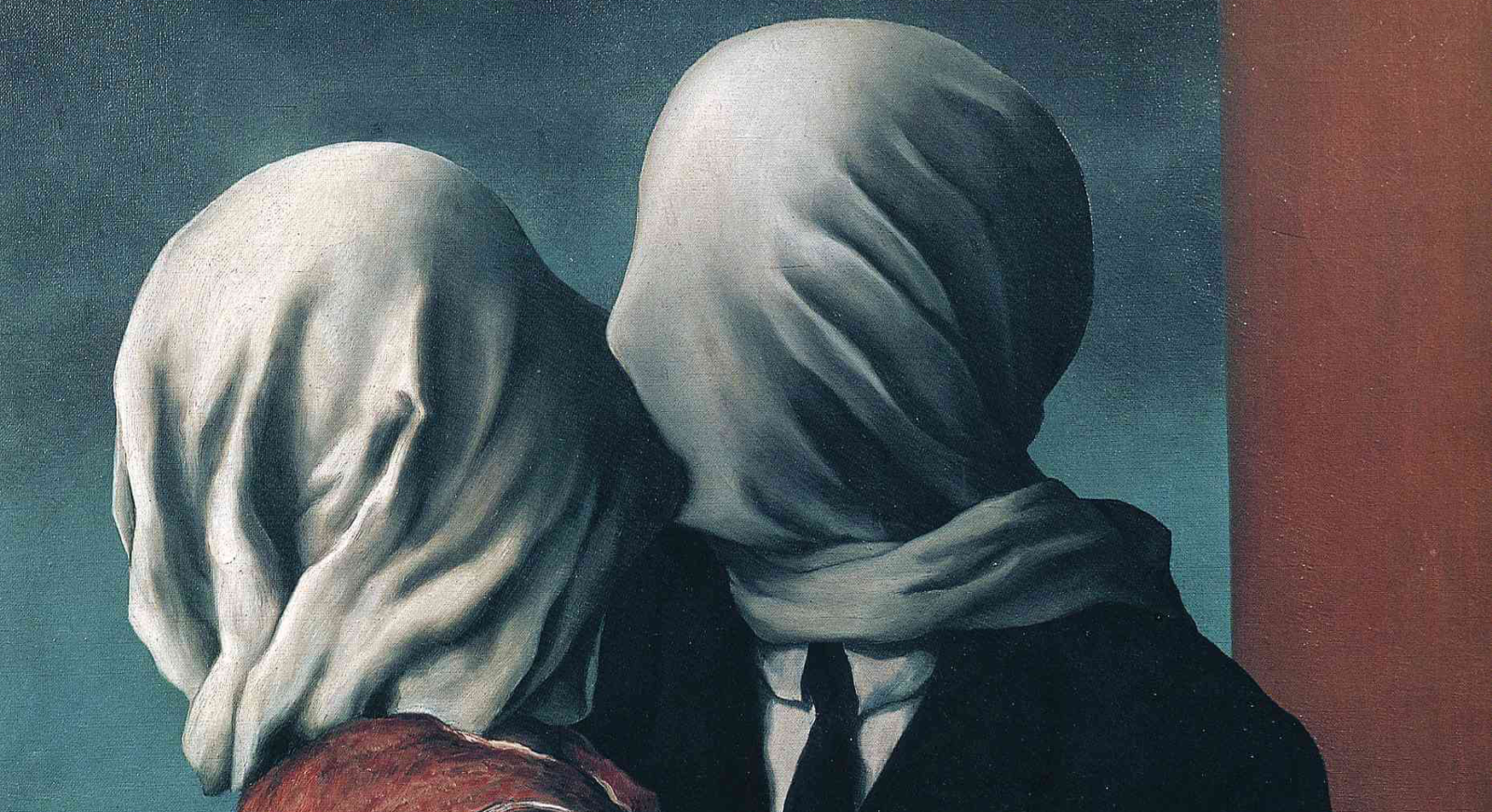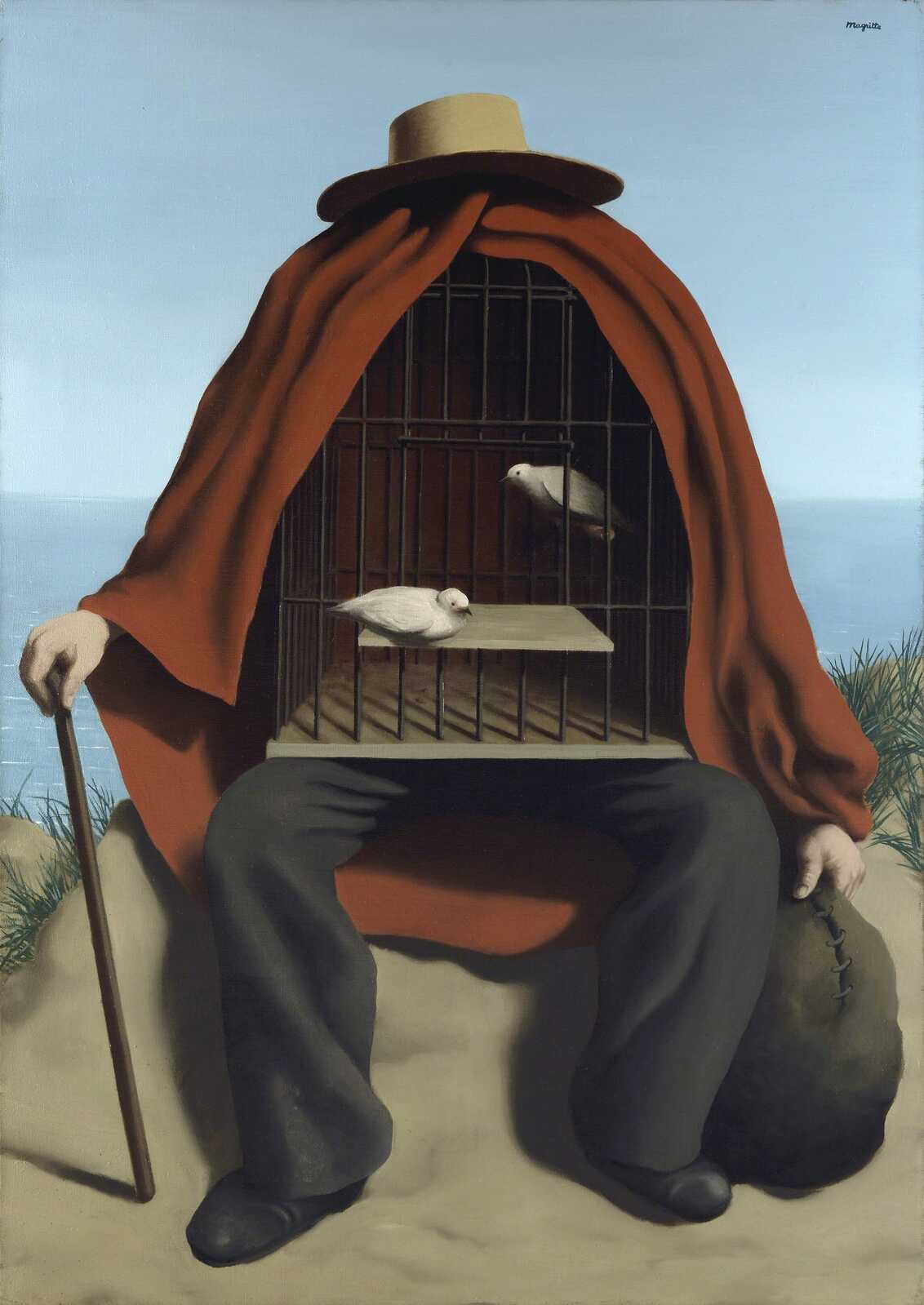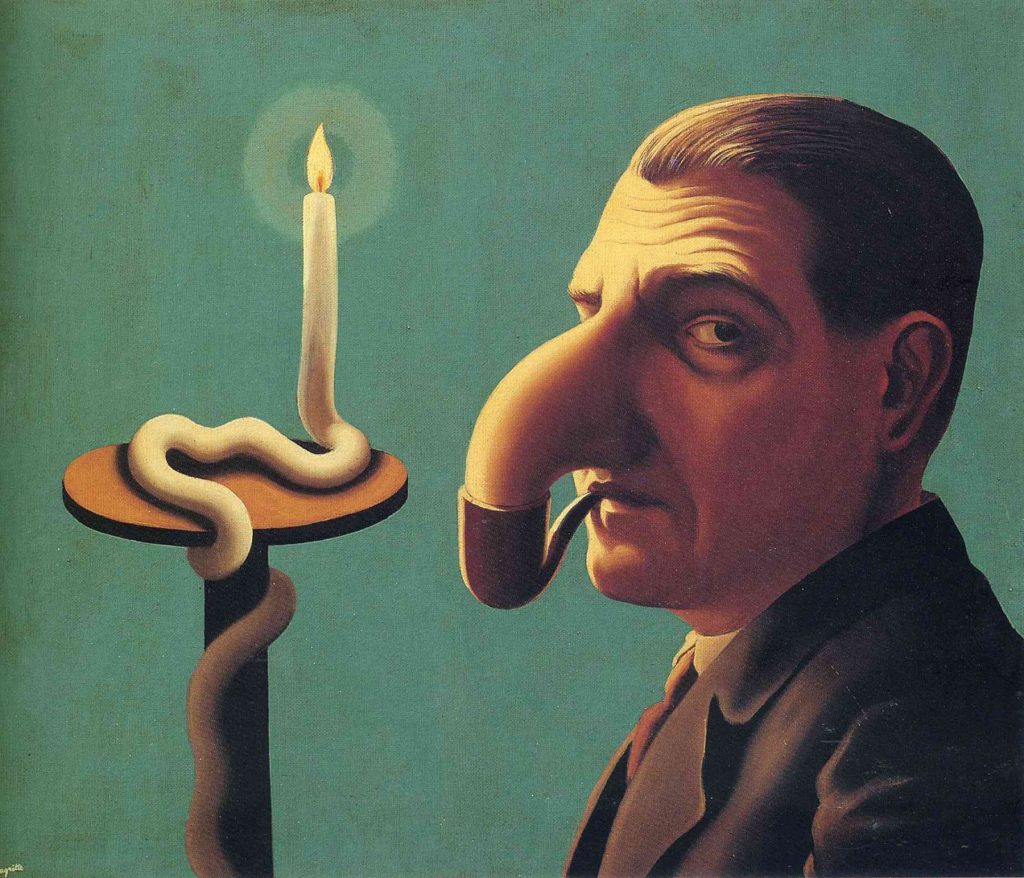[Partly edited December 8, 2008 and December
8, 2024]
20th Century Art, Music, and Literature
I've told you that one of the best ways to understand a
society is to look at the art, music, and literature it
produces. Looking at the Baroque style tells you a lot
about what is going on in the17th century. Looking at the
Rococo and Noe-Classical/Classical styles of the 18th century
tells you a lot about that time period. Looking at the
Romantic and Realistic styles of the 19th century also tells you
a lot about that century.
The artistic styles of the 20th century likewise tell you a lot
about that century. The problem is that their are dozens
of different styles and movements in the arts in the 20th
century, not just one or two that typify the century.
Nevertheless, regardless of style, one can point to three
particularly distinctive trends in much (though certainly not
all) 20th and 21st century art, music, and literature:
- A tendency to be less and less accessible to average
person
- A tendency to glorify art itself
- A tendency to undercut traditional standards and
values
As an example, consider the development of atonal music in
20th century.
Before the 20th century, serious music, even the
music of the greatest composers, was pretty easy for the
average person to understand and enjoy. Serious
music followed common and easily understood patterns (e.g., the
"I, IV, V, V7, I" harmonic pattern one finds frequently in
popular tunes).
In the 20th century, however, many of the most important
composers began to move away from these patterns toward what is
called atonal music. Atonal music is music without a home key.
There is a pattern, but the pattern is
not at all easy to recognize. Composers working in this
style prepare for themselves a 12 tone grid and then use the
grid systematically in producing their compositions.
[See this excellent video discussing
Schoenberg's method. Schoenberg's method is
sometimes just right for the theme. Here's Survivor
from Warsaw.]
[My son Michael put together an atonal piece he calls Sleepers Speak and Dance. A
challenge to the music majors: listen to the piece and see if
you can figure out why Mike gave the composition the title he
did. Looking at the
printed score makes things easier. One of the problems
with twelve-tone music is that, even a good musician often has
trouble understanding what's going on without the score in
front of them. ]
If one has an exceptionally good ear and special training, one
just might be able to hear the patterns in 12 tone music. But
Schoenberg doesn't even want you to be able to hear the
pattern. Obviously, this is music much less accessible to
the average person--and even to highly trained musicians!
How many people listen to and enjoy the music of Arnold
Schoenberg? Not many many. Even those that prefer
"serious" music to popular genres tend to listen more often to
the composers of earlier eras, to the Bachs, Beethovens, Chopins
and Mozarts rather then the Schoenbergs.
[But note that Schoenberg could and did
compose traditionally beautiful works--that get ignored!
You might enjoy Verklarte
Nacht.]
Twelve tone music also shows a clear tendency to glorify art
itself. What we are asked to admire here is the creativity
of the composer, his ability to find new ways to use the 12 tone
grid.
Also clear in atonal music is the tendency to undercut
traditional standards and values. The traditional idea was
that music should have pretty melodies and beautiful harmonies.
Composers, especially the Romantics, might occasionally use
dissonance (disturbing combinations of notes), but they did so
knowing full well that the effect was not particularly
pleasant. With atonal music, the situation is very
different. Playing a C and a C# at the same time creates
what would traditionally have been viewed as
dissonance--disharmony. Schoenberg said that this might
instead be what he called "distant harmony," and part of the
composers art might be to create a context where sounding a C
and a C# together is exactly the right way to complete one's
harmonic pattern.
Another 20th century composer working in the atonal style is
John Cage. Cage studied with Schoenberg and produced some
interesting 12-tone compositions of his own. But Cage went
on to develop another musical style, aleatoric music.
Atonal music sounds like random sounds even though it
isn't. Aleatoric music sounds like random sounds because
that's exact;u what it is! Cage
used many different methods to produce random sounds. He used
computers to generate random sounds, splashed paint over blown
up staff lines, etc. All this clearly violates the
traditional idea that music should follow a deliberate pattern.
If fact, Cage challenges virtually all traditional ideas of what
music should be. In one of Cage's compositions (4:33) the
composer sits down at the piano--and does nothing for 4:33!!!
Many other 20th century composers use the aleatoric style
is some passages, e.g., Igor Stravinsky in his Rite of
Spring. One critic described this work as "raw sound freed
from melody and harmony," what most of us would call
noise.
[ Is noise
music? Cage thought so. Here's a clip of Cage's Noise.]
In the
visual arts too one can see the tendencies I describe.
Typical of 20th century art is the development of Cubism by
artists like Pablo Picasso and Marcel Duchamp.
In Cubist art, the painter tries to combine multiple
perspectives, looking at an object from 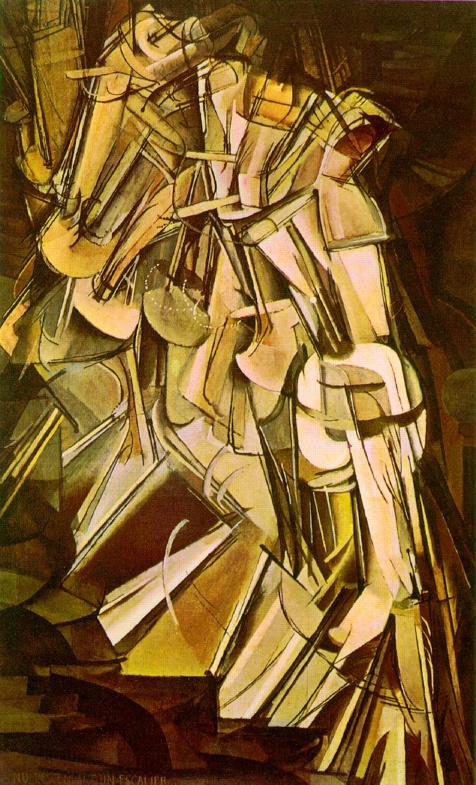 different
points of view and sometimes at different times. Marcel
Duchamp's Nude Descending a staircase is a
good example. The painting is impressive in its
discovery of a way of conveying a sense of motion in a still
image. But the average person looking at a work like
this can't even tell what it is!
different
points of view and sometimes at different times. Marcel
Duchamp's Nude Descending a staircase is a
good example. The painting is impressive in its
discovery of a way of conveying a sense of motion in a still
image. But the average person looking at a work like
this can't even tell what it is!
The situation is even worse with a 20th century style
called Abstract Expressionism. In Abstract Expressionism
there are no recognizable objects. What we are asked to
appreciate is the artist's use of color, line,
composition. We get the expression of an artists
feelings--or (perhaps) the results of purely accidental
processes only partly under the artist's conscious control.
Soviet dictator Nikita Khrushchev described one
abstract work as looking like what would happen if a little
boy had done his business on canvas and spread it around when
his mother wasn't watching. And, to the average person--maybe
even to trained artists--this isn't so far from the truth.
There's an even greater challenge to traditional standards
of what art should be like in a style called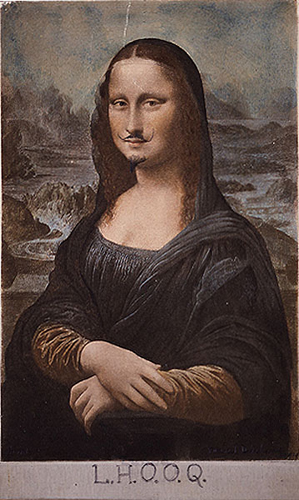 Dada.
In Dadaist works (like those of Marcel Duchamp), there is a
deliberate attempt to eliminate all
previous artistic standards. Take a dead, stuffed monkey
(as did Francis Picabia). Label it on three different
sides "Portrait of Rembrandt," "Portrait of Renoir," and
"Portrait of Cezanne." And there's your work of art!
Draw a mustache and beard on a reproduction
Dada.
In Dadaist works (like those of Marcel Duchamp), there is a
deliberate attempt to eliminate all
previous artistic standards. Take a dead, stuffed monkey
(as did Francis Picabia). Label it on three different
sides "Portrait of Rembrandt," "Portrait of Renoir," and
"Portrait of Cezanne." And there's your work of art!
Draw a mustache and beard on a reproduction of the Mona Lisa
(Duchamp again),
give the picture a title with a semi-obscene double entendre (the
letters
on the bottom are pronounced "elle a chaud au caul")
and there's your work of art. Duchamp
here (and elsewhere) is deliberately trying to destroy
traditional ideas of what art should be like. "There's a great
work of destruction to be done." And the great tool of
destruction? Often, it's humor. See Duchamp's "Fountain"
(left).
of the Mona Lisa
(Duchamp again),
give the picture a title with a semi-obscene double entendre (the
letters
on the bottom are pronounced "elle a chaud au caul")
and there's your work of art. Duchamp
here (and elsewhere) is deliberately trying to destroy
traditional ideas of what art should be like. "There's a great
work of destruction to be done." And the great tool of
destruction? Often, it's humor. See Duchamp's "Fountain"
(left).
The Dadaist movement prepared the way for
another movement in the arts, Surrealism. Surrealism
is
a style, not just of painting, but of music and literature as
well. In some ways, Surrealism is
the best example of trends I talk about.
Surrealism's challenge to traditional standards
clear. The surrealists (men like Salvador Dali) say that
what the rest of us regard as reality
isn't truly reality. There is a deeper reality in the
subconscious mind, and true art should reflect that deeper
reality. Notice the twist: what most of us would consider a
distortion of reality is proclaimed by the Surrealists as the
true reality. Surrealists incorporate automatism and accident
rather than logical control as they create their artistic works.
Also, the Surrealists tend to emphasize things the rest of
us find disturbing in the extreme--and they tell us these these
things are good! Exceeding one's wildest imagination is
the goal here--and nightmare visions, because they are so wild,
are the epitome of beauty. "The
marvelous is beautiful," they tell us. "Only
the marvelous is beautiful." For Surrealists like Salvador
Dali, a flaming giraffe is beautiful. And Magritte's depictions
of a "healer," "a philospher," and "lovers? Beautiful!
At the opposite extreme, there is Pop Art, a style that gives
us, not unfamiliar images, but images that are as familiar as
they can possibly be. The most famous of the Pop artists
is Andy Warhol. Warhol gave us images from popular culture
transformed into art: Campbell's soup cans, Coke bottles, images
of Jackie Kennedy, images of Marilyn Monroe. The trouble
for us here is that it's hard to tell exactly what's going
on. What's Warhol's attitude toward popular culture.
Is he embracing it, or making fun of it? Is this simply a
continuation of Dada? Hard to say.
In most of these artistic styles there is a deliberate
attempt to shock the aesthetic sense, to produce something that
will challenge existing standards. In fact, in much modern
art, the only value in a piece is its shock value--and the more
shocking, the more likely the art world is to regard a
work as important. Robert Maplethorpe gives us pictures of
homosexual men in various sado-masochistic poses--and we've got
art. Andres Serrano gives us a crucifix upside-down in a
jar of urine: and we've got a work art. One recent exhibit
required viewers to walk over American flags in order to see the
other images.
This kind of thing was rare or non-existent in earlier artistic
styles which usually tended to reinforce religion, patriotism,
and traditional standards. Only in the 20th
century would such things be regarded as art.
20th century literature, too, reflects the trends I
mention above. An excellent example,
what's happened to poetry.
For most of human history, the works of the great poets were
easy for the average person to understand and enjoy. The
average person living in ancient Greece would have had no
trouble understanding and enjoying the works of Homer. The
average Roman would have had no difficulty understanding and
enjoying the works of Catullus, Ovid, or Virgil. The
average person of the Middle Ages would have had no difficulty
enjoying the Song of Roland. Clear up through the 19th century,
serious poets could be read and enjoyed by almost anyone.
In the 20th century, however, serious poetry took a turn away
from easy accessibility. Here's an example:
T.S. Eliot (1888–1965). Poems.
1920.
12. Sweeney among the Nightingales

APENECK SWEENEY spreads his knees
Letting his arms hang down to laugh,
The zebra stripes along his jaw
Swelling to maculate giraffe.
The circles of the stormy moon
5
Slide westward toward the River Plate,
Death and the Raven drift above
And Sweeney guards the hornèd gate.
Gloomy Orion and the Dog
Are veiled; and hushed the shrunken
seas;
10
The person in the Spanish cape
Tries to sit on Sweeney’s knees
Slips and pulls the table cloth
Overturns a coffee-cup,
Reorganised upon the floor
15
She yawns and draws a stocking up;
The silent man in mocha brown
Sprawls at the window-sill and gapes;
The waiter brings in oranges
Bananas figs and hothouse grapes;
20
The silent vertebrate in brown
Contracts and concentrates, withdraws;
Rachel née Rabinovitch
Tears at the grapes with murderous
paws;
She and the lady in the cape
25
Are suspect, thought to be in league;
Therefore the man with heavy eyes
Declines the gambit, shows fatigue,
Leaves the room and reappears
Outside the window, leaning in,
30
Branches of wistaria
Circumscribe a golden grin;
The host with someone indistinct
Converses at the door apart,
The nightingales are singing near
35
The Convent of the Sacred Heart,
And sang within the bloody wood
When Agamemnon cried aloud,
And let their liquid siftings fall
To stain the stiff dishonoured shroud.
40
What's going on here? Unfortunately, in order to
figure it out, you have to know extraordinarily well images
from classical literature and other sources--but, also,
details of Eliot's personal life. It turns out to be a
great poem, but how are we to know?
At least here we are left with some traditional
elements poetic elements: rhyme, meter, memorable
images. But what are we to do with poems that abandon
all these things, as much contemporary poetry does?
Well, we abandon them. 20th century serious poetry isn't
easily accessible, and so most of us give up.
And most of us have given up on serious novels as
well--or, at least, we've given up on some of those novelists
the English professors would tell us are particularly
important. One such, James Joyce.
James Joyce was a pioneer of what is called "Stream of
Consciousness" writing. Here's an example from his
"Portrait of the Artist as a Young Man."
Chapter 1
Once
upon a time and a very good time it was there was a moocow coming
down along the road and this moocow that was coming down along the
road met a nicens little boy named baby tuckoo
His father told him that story: his father looked at him through
a glass: he had a hairy face.
He was baby tuckoo. The moocow came down the road where Betty
Byrne lived: she sold lemon platt.
O, the wild rose blossoms
On the little green place.
He sang that song. That was his song.
O, the green wothe botheth.
When you wet the bed first it is warm then it gets cold. His
mother put on the oilsheet. That had the queer smell.
His mother had a nicer smell than his father. She played on the
piano the sailor's hornpipe for him to dance. He danced:
Tralala lala,
Tralala tralaladdy,
Tralala lala,
Tralala lala.
Uncle Charles and Dante clapped. They were older than his father
and mother but uncle Charles was older than Dante.
Dante had two brushes in her press. The brush with the maroon
velvet back was for Michael Davitt and the brush with the green
velvet back was for Parnell. Dante gave him a cachou every time he
brought her a piece of tissue paper.
The Vances lived in number seven. They had a different father and
mother. They were Eileen's father and mother. When they were grown
up he was going to marry Eileen. He hid under the table. His
mother said:
-- O, Stephen will apologize.
Dante said:
-- O, if not, the eagles will come and pull out his eyes.--
Pull out his eyes,
Apologize,
Apologize,
Pull out his eyes.
Apologize,
Pull out his eyes,
Pull out his eyes,
Apologize.
Now this is impressive stuff, a great way of (in this
case) presenting the earliest childhood memories of Joyce's
central character, Stephen Dedalus (who, by the way, is
basically Joyce himself very thinly disguised). But,
obviously, this is not the kind of stuff that is easy for the
average person! Even more difficult is Joyce's most
famous work, Ulysses.
In addition to showing the tendency to be less
accessible to the average person, Joyce's work shows the
tendency to undercut traditional standards and values.
The plot of Ulysses runs parallel to Homer's Odyssey, and
every character in the book has a parallel character in the
Odyssey. But the basic values are far different.
In the Odyssey, Penelope is the model of the faithful wife,
waiting 20 years for her husbands return. In Ulysses,
the corresponding character, Molly Blume, is anything but
faithful--and with Joyce's apparent approval. Likewise,
Joyce's "hero" (Leopold Blume) certainly isn't heroic in the
traditional sense.
Further, Joyce's work show's the tendency to glorify
art itself. In Portrait of the Artist as a Young Man,
the young Steven Dedalus throws away his Catholic faith for a
new religion: the religion of art. For Joyce (and for
many other modern artists/writers) art really is a replacement
for religion, and we look to the arts for answers that people
once sought in religion.
Another 20th century writer using the stream of
consciousness style is Samuel Beckett. Beckett worked
with Joyce directly for a time (helping with Ulysses), and
then went on to write novels of his own, e.g., Molloy.
[See here the sucking-stone passage I talk
about in class.]
Beckett's novels are filled with events with no logical
connection. "Absurd!" says the reader. "Right!"
says Beckett. But life itself is absurd: much of what we
do has no meaning, and literature should reflect the
absurdities of life.
Beckett expresses even better his ideas on life in his
theatrical works, works like Waiting for Godot.
Waiting for
Godot is perhaps the most famous example of what is
called Theater of the Absurd. The two central
characters, Didi and Pogo, ramble on about this and that, and
there doesn't seem to be much logical connection to the things
they say or the things that happen to them. But then, in
the middle of the play there is a moment where we think we are
going to get clarity:
"Let us not waste our time in idle discourse! Let us do something,
while we have the chance! It is not every day that we are needed.
Not indeed that we personally are needed. Others would meet the case
equally well, if not better. To all mankind they were addressed,
those cries for help still ringing in our ears! But at this place,
at this moment of time, all mankind is us, whether we like it or
not. Let us make the most of it, before it is too late! Let us
represent worthily for once the foul brood to which a cruel fate
consigned us! What do you say? It is true that when with folded arms
we weigh the pros and cons we are no less a credit to our species.
The tiger bounds to the help of his congeners without the least
reflection, or else he slinks away into the depths of the thickets.
But that is not the question. What are we doing here, that is the
question. And we are blessed in this, that we happen to know the
answer. Yes, in this immense confusion one thing alone is clear. We
are waiting for Godot to come—or for night to fall. We have
kept our appointment, and there's an end in that. How many
people can boast as much?"
"Billions"
What are we doing here? We are waiting for Godot to
come. Notice that Godot is GODot. We are waiting for
God--or, at least, a revelation of purpose of some sort.
But guess what? Godot never shows up. Message:
there's not much point waiting to find out the meaning of
life. You won't find the meaning of life because life has
no meaning. Bleak, bleak, bleak stuff--except it isn't, or
it isn't supposed to be.
Beckett subtitles his work a comedy in two acts (well, a
tragicomedy says Wikipedia). We are supposed to be
laughing. And that's what Beckett thinks we should do with
life. Since we aren't going to find any meaning in life,
all we can do is laugh at its absurdities. And do you see
how important art becomes from this point of view? It's
our artists and writers who point out the absurdities, help us
laugh at them and make life bearable.
Another master of the Theater of the Absurd style is Eugene
Ionesco. Both Beckett and Ionesco won Noble prizes, and
Ionesco's plays were particularly successful. As of April 2024,
The Bald Soprano
had a run of 67 years at Paris playhouse--the longest run in all
theater history.
One of my favorite Ionesco plays is "A Stroll in the Air."
At one point, the central character, a writer named Berrenger,
mourns the utter meaninglessness of life. He says he used to
take pleasure in saying that there was nothing to say, but that,
now he is so sure he was right, he can't even do that
anymore. Again, bleak bleak stuff.
But that's not the end of the play: it's the beginning!
Berrenger goes out for a walk, and ends up "strolling through
the air," essentially, flying. Ionesco's message:
when you see the absurdity and meaninglessness of life, don't
give up in despair. Take a leap--with your
imagination. And, once again, one sees how important the
arts become from this point of view. Since life has no
meaning, it's our imaginations that give us the most we can hope
to get out of life, and those people who inspire our
imagination--well, let's have a round of applause for them,
shall we?
Closely related to the Theater of the Absurd are the works of
existentialist writers like Jean Paul Sartre. Albert Camus
is my favorite of the existentialists, and I used to like
Heinrich Boll. However, the most famous of these writers
(and the one I talk about in class) is Jean-Paul Sartre.
In the years after World War II, Sartre was treated basically
like a rock star in France. His philosophical works,
plays, and novels were extraordinarily popular.
Eventually, he was offered a Nobel prize for literature--which
he turned down. His was surrounded by thousands of
admiring young people. What did he have to offer? A
special flavor of the existentialist philosophy.
There are several types of existentialism, but Sartre's brand is
what's called atheistic existentialism. It begins with the
idea that there is no God.
Now we have looked at atheistic philosophers already: Comte and
Marx, for instance. But Sartre differs greatly from
earlier atheistic philosophers in his attitude toward the
godless world. For Comte and Marx, the idea that there was
no God was liberating--a thing to be celebrated. For
Sartre, it was a very bad thing that there was no god. If
there is no God, there can be no universal standards of right
and wrong. If there is a God, what God says is right is
right, what God says is wrong is wrong. But if there is no
God, all ideas are subjective--and that makes our lives very
difficult. How can we know what to do, how can we confront
difficult ethical decisions if we have no objective standards of
morality? Sartre's version of existentialism seeks a way out of
this dilemma, offering a way of making moral decisions in the
absence of objective standards of right and wrong.
Sartre says that, before taking any action, we should look deep
within ourselves to discover where our own true values are, and
then should act accordingly. If we do this, we will have
acted in "good faith," authentically. If, on the other
hand we do not look deeply within ourselves or if we fail to act
in accord with that which is deepest within us, we will have
acted in "bad faith," inauthentically.
Now this seems a plausible philosophy of life, similar to
Polonius' advice in Hamlet, "This above all to thine own self be
true." But what happens when one tries to apply this
philosophy?
When I was in high school, I really liked Jean-Paul
Sartre--especially his plays. One of Sartre's books was called
"St. Genet, Actor and Martyr." It's about another French
writer, Jean Genet, a writer Sartre greatly admired. I
figured that, if Sartre liked him, Genet must be something
special. There were no Genet books in the library, so I
went to the bookstore and ordered a Genet book, "Our Lady of the
Flowers."
It's the only book I have ever burned. The book is filthy,
featuring the most degraded and degrading stuff imaginable. So
why did Sartre like it? Because Genet wrote about what he
*really* thought, what he *really* felt. Genet was,
therefore, "authentic"--and therefore good: good enough so that
we should call Genet a saint! Note the tendency to stand
traditional ideas on their head!
In Sartre's personal life, too, the existential philosophy led
to an inversion of the usual moral standards. As Sartre
looked within himself he saw a couple of things. He admits
that he is unable to love. He admits that, as far as sex
is concerned, incest appeals to him. His books and plays
often applaud incestuous relationships. And in his
personal life--well, Sartre had a long-time live-in girlfriend,
Simone de Beauvoir--his wife in everything but the legal
sense. Simone's young women students would often come to
their home--and Sartre would seduce these young girls one after
another. Horrible behavior in a conventional sense--but,
from Sartre's point of view he was acting "authentically."
He really wanted these girls, and so, the "right" thing to do is
to act in accord with what he just happened to find deepest
within himself.
[Simone de Beauvoir was the leading French
feminist writer of the time, and, when she died, French
feminists proclaimed that they owed her "everything."
Part of what they owed her a breaking down of the standards
women can expect from the men in their lives.]
Interesting also is the political philosophy Sartre's
existentialism leads him to adopt: Marxism. How is it that being
"authentic" leads one to adopt such a brutal philosophy?
My guess is that Marx, and many other modern artists and
literary figures, are drawn to Marxism because of their hatred
of the "bourgeoisie," and everything associated with middle
class values. An awful lot of modern art and literature is
an attack on middle class values, an attempt to shock the
bourgeoisie.
One example, a play we did at Stanford in the 1970's, Fernando
Arabel's "The Architect and the Empire of Assyria." The
play was designed to shock, featuring nudity, simulated
cannibalism, references to drinking urine and playing with
excrement, sadomasochistic priests, pregnant nuns, and
blasphemous lines.
But did it shock? Hardly. The audience, for the most part,
loved it.
"Shocking the bourgeoisie," a strategy adopted by so
many modern audience, didn't work in the way that they
intended. It did result in the breaking down of
standards: if the great "artists" didn't have to follow the
rules, why should anyone else? As the new standards
filtered down into popular culture, the mediocre, banal and
insipid was replaced but stuff that was equally mediocre,
banal, and insipid--and debasing at the same time.
This was not the way it was supposed to be. 20th
century artists musicians and writers did want to break down
traditional standards, but the idea was always that this
would be done to put up something better in their place.
And sometimes, artists have succeeded. But in too many
instance, this just didn't happen. Plenty was destroyed,
but what came out of the ashes wasn't always so good.
Instead, the result of many of these 20th century artistic
movements has been despair, perversion, suicide, misery--not
least for the artists themselves. You see, many of the
people I have been talking about, for all their talent, were
not very nice people, nor very happy people.
Pablo Picasso was a tremendous success--about as
successful as an artist can be. He had young women
throwing themselves at him, all wanting to sleep with this
great genius. Picasso was the kind of guy who likes a
cigarette after sex. And what he would do is that,
instead of reaching for an ash tray, he'd put out his
cigarettes on the body of the young woman he was
sleeping with.
Psychologically healthy men do not treat women like
this, and the absolutely awful way so many of the great
"artists" of the 20th century treated women is strong evidence
that they were not happy campers, and that there was something
seriously wrong in their approach to life. There seems
to be a wrong turn--and it's easy to guess exactly where that
wrong turn came.
Sartre wrote a short autobiography he called "The
Words." He describes his early years and his early
education in the Catholic schools of France. He once turned in
an essay on the Passion, the crucifixion of Christ. It had
delighted his family, but it was awarded only a 2nd prize.
He was disappointed not to be first, and said that this
disappointment drove him into prayerlessness. He
"maintained public relations with the Almighty, but privately
ceased to associate with him."
"Only once," says Sartre, "did I have the feeling he existed.
I had been playing with matches and burned a small
rug. I was in the process of covering up my crime when God
saw me. I felt his gaze inside my head and on my
hands. I whirled about in the bathroom, horribly visible,
a live target. Indignation saved me. I flew into a rage
against so crude an indescretion, I blasphemed like my
grandfather: 'God damn it, God damn it, God damn it.' He never
looked at me again.
This, it seems to me, is the wrong turn taken, not just
by Sartre, but by much of the 20th century. We live in a
society that has turned it's back on God, that thinks there's
something immoral and even illegal in talking about God. In
this class, many of you are uncomfortable whenever I bring up
religious subjects, and perhaps you think I'm doing something
wrong. But I want you to consider something
exceedingly strange about our society. I could stand up
before a class and swear like John Paul Sartre (God d----) and
nobody would bat an eyelash. I could stand up and
blaspheme like Arabel (God's gone crazy...). And nobody
would do a thing about it. But suppose I talked in a
different way about God.
Suppose, instead of saying god d--- all the time as so
many people on this campus do, I used phrases like, "Glory to
God", "Praise the Lord." "Praise be to God." I'd
get into trouble, wouldn't I?
Suppose I told you that you ought to love God with all
heart, soul, mind, and strength. I'd get into trouble,
wouldn't I? And suppose I told you that the only life worth
living was a life lived in obedience to the word of God.
I'd get into trouble.
And when my students come to me, as they often do, with
tears in their eyes over the latest tragedy in their lives,
carrying burdens so heavy that it breaks my heart--suppose I
told them what I would so much like to tell them about, a God
who knows every burden they carry, and wants to dry every
tear, and to give them lives of joy and peace and
happiness--I'd get into trouble, wouldn't I?
And if the shoe were on the other foot, as it so often
is, and after another dreadfully difficult day where I am
struggling to keep up, if I wasn't really up for a lecture,
and started class by asking students to take a few minutes to
pray for me, well, I'd get into trouble, wouldn't I?
And so I won't do any of those things. But I will tell
you this. Ideas have consequences. Every major
development in history begins with a set of ideas. The
French Revolution, the Holocaust, Stalin's reign of
terror--all began with ideas, ideas taught and spread in
university classrooms. Some of you are bored with ideas: but
remember that it makes a real difference which ideas win
out. And remember that, every time you step onto a
university campus, you are stepping on to a battleground--and
battle for student hearts and minds--and, perhaps, for their
souls as well.
Good luck on the final exam.
 different
points of view and sometimes at different times. Marcel
Duchamp's Nude Descending a staircase is a
good example. The painting is impressive in its
discovery of a way of conveying a sense of motion in a still
image. But the average person looking at a work like
this can't even tell what it is!
different
points of view and sometimes at different times. Marcel
Duchamp's Nude Descending a staircase is a
good example. The painting is impressive in its
discovery of a way of conveying a sense of motion in a still
image. But the average person looking at a work like
this can't even tell what it is! Dada.
In Dadaist works (like those of Marcel Duchamp), there is a
deliberate attempt to eliminate all
previous artistic standards. Take a dead, stuffed monkey
(as did Francis Picabia). Label it on three different
sides "Portrait of Rembrandt," "Portrait of Renoir," and
"Portrait of Cezanne." And there's your work of art!
Draw a mustache and beard on a reproduction
Dada.
In Dadaist works (like those of Marcel Duchamp), there is a
deliberate attempt to eliminate all
previous artistic standards. Take a dead, stuffed monkey
(as did Francis Picabia). Label it on three different
sides "Portrait of Rembrandt," "Portrait of Renoir," and
"Portrait of Cezanne." And there's your work of art!
Draw a mustache and beard on a reproduction of the Mona Lisa
(Duchamp again),
give the picture a title with a semi-obscene double entendre (the
letters
on the bottom are pronounced "elle a chaud au caul")
and there's your work of art. Duchamp
here (and elsewhere) is deliberately trying to destroy
traditional ideas of what art should be like. "There's a great
work of destruction to be done." And the great tool of
destruction? Often, it's humor. See Duchamp's "Fountain"
(left).
of the Mona Lisa
(Duchamp again),
give the picture a title with a semi-obscene double entendre (the
letters
on the bottom are pronounced "elle a chaud au caul")
and there's your work of art. Duchamp
here (and elsewhere) is deliberately trying to destroy
traditional ideas of what art should be like. "There's a great
work of destruction to be done." And the great tool of
destruction? Often, it's humor. See Duchamp's "Fountain"
(left).